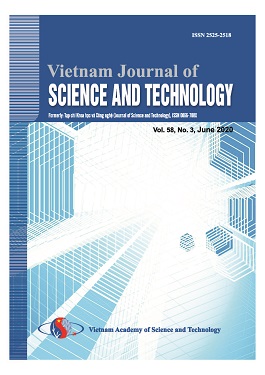Numerical simulation for determination of temperature field and residual stress of stainless steel butt joints with and without clamping
Author affiliations
DOI:
https://doi.org/10.15625/2525-2518/16486Keywords:
butt joint, finite element model, , MIG welding, residual stress, stainless steelAbstract
Many welded structures are fabricated from stainless steels because these steels have good mechanical properties and good corrosion resistance. It is necessary to predict the residual stress after welding in order to evaluate the performance of the welded joint. In this paper, the butt welded joint of AISI 316L stainless steel plates is studied. The Metal Inert Gas (MIG) welding process is selected for this material. A SYSWELD software based on the Finite Element Method (FEM) is used to determine the temperature field and residual stresses of two stainless steel plates. The welding simulation includes a sequential coupled thermomechanical analysis. The elemental generation and death technique is utilized to simulate metal deposition in welding. The double ellipsoidal heat source model is used for the heat input of the MIG welding process. The temperature distribution for various time steps at some important points is presented. Cooling times and cooling rates over a temperature range of 800 oC to 500 oC at these points are determined. The residual stress distribution in the longitudinal and transverse direction in two cases with and without clamping is obtained and compared. Obtained results show that: the temperature field in the case of clamping is the same as in the case of no clamping; only the longitudinal stress and transverse stress components are important, the other stress components are not important; the longitudinal stress at the middle of weld line is very high; the transverse stress in the case of clamping is greatly increased, so it is necessary to limit clamping to reduce residual stress after weldingDownloads
References
Ghosh N., Pal P. K., Nandi G. - Parametric optimization of MIG welding on 316L austenitic stainless steel by Taguchi method, Archives of Materials Science and Engineering, 79/1 (2016) 27-36.
Jeyakumar M., Christopher T., Naraynan R., Nageswara Rao B. - Residual stress evaluation in butt-welded steel plates, Indian Journal of Engineering & Materials Sciences 18 (2011) 425-434.
Lee S. H., Kim E. S., Park J. Y., Choi J. - Numerical analysis of thermal deformation and residual stress in automotive muffler by MIG welding, Journal of Computational Design and Engineering 5 (2018) 382-390.
Raffaele Sepe, Alessandro De Luca, Alessandro Greco, Enrico Armentani - Numerical evaluation of temperature fields and residual stresses in butt weld joints and comparison with experimental measurements, Fatigue & Fracture of Engineering Materials & Structures 44 (2021) 182-198.
Dhayanithi Venkatkumar, Durairaj Ravindran - Effect of boundary conditions on residual stresses and distortion in 316 stainless steel butt welded plate, High Temperature Materials and Processes 38 (2019) 827-836.
ESI Group - Sysweld 2017 Reference manual, January 2017.
John A. Goldak, Mehdi Akhlaghi - Computational welding mechanics, Springer, 2005.
Nguyen N. T. - Thermal analysis of welds, WIT press, 2004.
Venkata K. A., Truman C. E., Wimpory R. C., Pirling T. - Numerical simulation of three-pass TIG welding using finite element method with validation from measurements, International Journal of Pressure Vessels and Piping 164 (2017) 68-79.
Damian Kotecki, Frank Armao - Stainless Steels – Welding Guide, Lincoln Electric, 2003, pp. 68-79.
Trochun I. P. - Internal forces and deformations during welding, State Scientific and Technical Publishing House of Machine-Building Literature, Moscow, 1964 (in Russian).
GSI SLV Duisburg - The welding engineer’s current knowledge: International Welding Engineering, 2015.
Downloads
Published
How to Cite
Issue
Section
License

This work is licensed under a Creative Commons Attribution-ShareAlike 4.0 International License.
Vietnam Journal of Sciences and Technology (VJST) is an open access and peer-reviewed journal. All academic publications could be made free to read and downloaded for everyone. In addition, articles are published under term of the Creative Commons Attribution-ShareAlike 4.0 International (CC BY-SA) Licence which permits use, distribution and reproduction in any medium, provided the original work is properly cited & ShareAlike terms followed.
Copyright on any research article published in VJST is retained by the respective author(s), without restrictions. Authors grant VAST Journals System a license to publish the article and identify itself as the original publisher. Upon author(s) by giving permission to VJST either via VJST journal portal or other channel to publish their research work in VJST agrees to all the terms and conditions of https://creativecommons.org/licenses/by-sa/4.0/ License and terms & condition set by VJST.
Authors have the responsibility of to secure all necessary copyright permissions for the use of 3rd-party materials in their manuscript.







 Vietnam Journal of Science and Technology (VJST) is pleased to notice:
Vietnam Journal of Science and Technology (VJST) is pleased to notice: